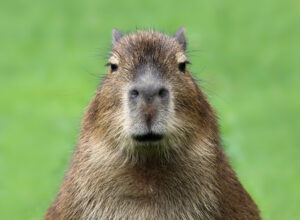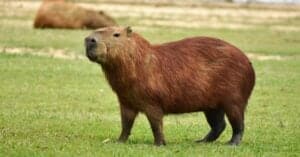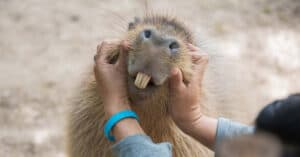Capybaras are the world’s largest rodents. They live in South America in forests and grasslands near water sources such as rivers, streams, or marshes. A baby capybara is called a pup and looks like a miniature version of an adult capybara. Baby capybaras live in family groups consisting of a dominant male, several females, and subordinate males. Once they reach maturity, capybaras set off to find a new family group. Let’s look at some adorable pictures of baby capybaras and learn more about these amazing animals!
1: Capybaras Gestate for Four to Five Months

Capybaras have a long gestation period. They stay pregnant for 120 to 150 days.
©Japan’s Fireworks/Shutterstock.com
The capybara gestation period lasts from about 120 to 150 days. That means capybaras stay pregnant much longer than mice, which have a gestation period averaging about 21 days, or rats, which average about 30 days. Even though capybaras don’t give birth for approximately four to five months, they do not have the longest gestation period of all rodents. The Brazilian porcupine stays pregnant for up to 201 days!
2: Capybaras Average Four Pups Per Litter
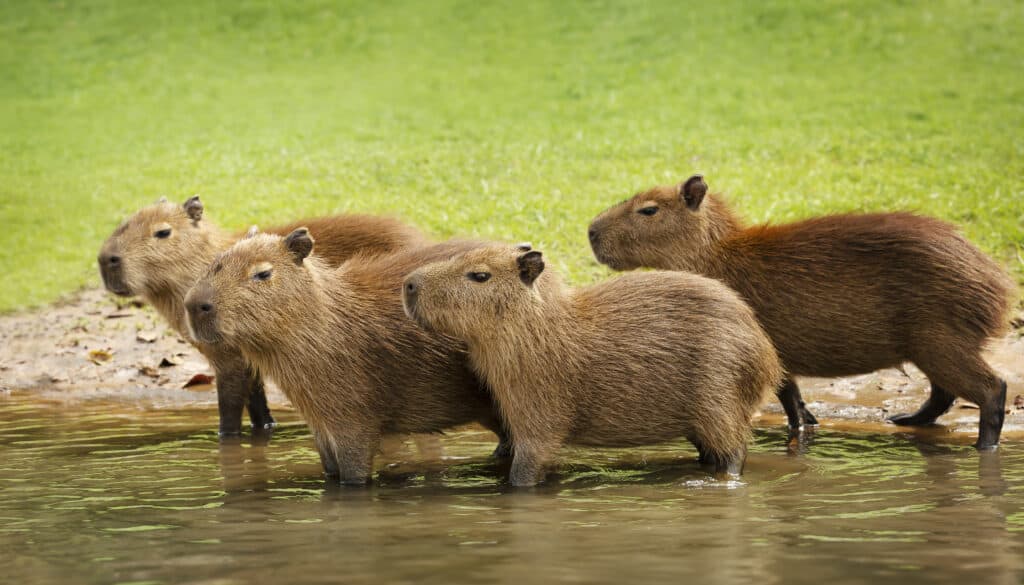
Capybaras average four pups per litter, though they can give birth to as many as eight.
©Giedriius/Shutterstock.com
Female capybaras give birth to anywhere from two to eight pups at a time. Their litters usually average about four pups, weighing approximately 2 to 3 pounds. Capybaras generally have only one litter per year. Their mating season varies based on the conditions within their specific habitat and the availability of mates within their group.
3: Baby Capybaras Are Born with Teeth
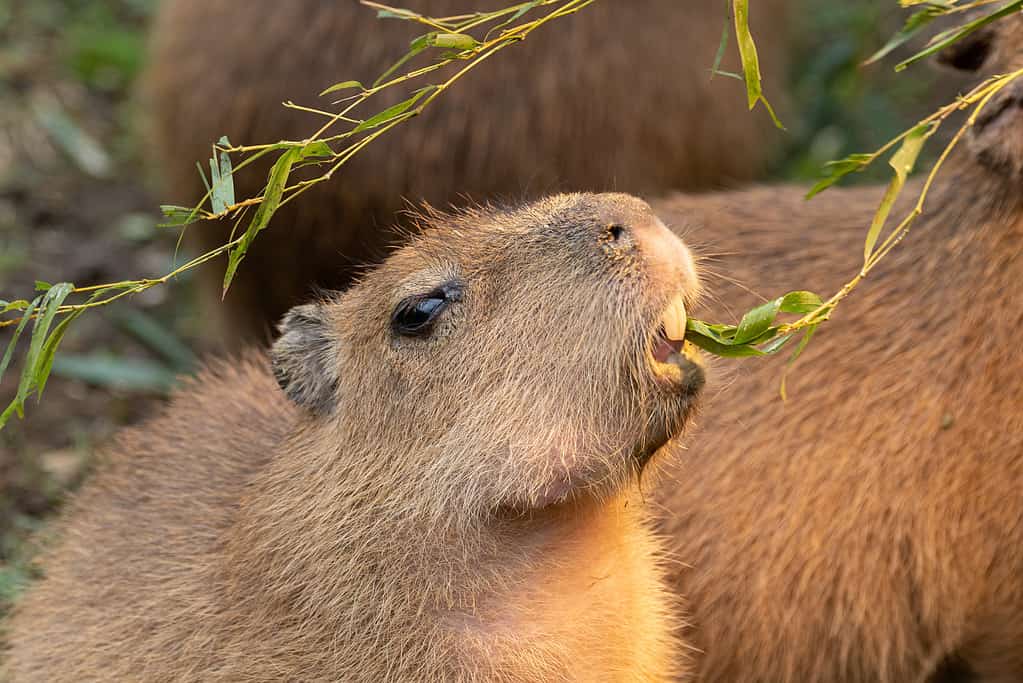
Baby capybaras already have cheek teeth and incisor buds when they are born.
©rai/iStock via Getty Images
Capybara pups are born with their cheek teeth already emerged and incisor buds ready to start growing. The capybara has three pairs of molars on the top and bottom of its jaw. Ahead of those are single premolars. That makes four excellent chewing teeth on the top and bottom of each side of a capybara’s mouth. In addition to these 16 cheek teeth, capybaras have two pairs of incisors at the front of their mouth for 20 teeth. These long, strong incisors are set apart from the premolars and molars by a gap called the diastema. Like other familiar rodents, the teeth of the capybara never stop growing. They grind against each other and against the hard and fibrous food the capybara eats, wearing down as they grow.
4: Baby Capybaras Are Precocial Animals
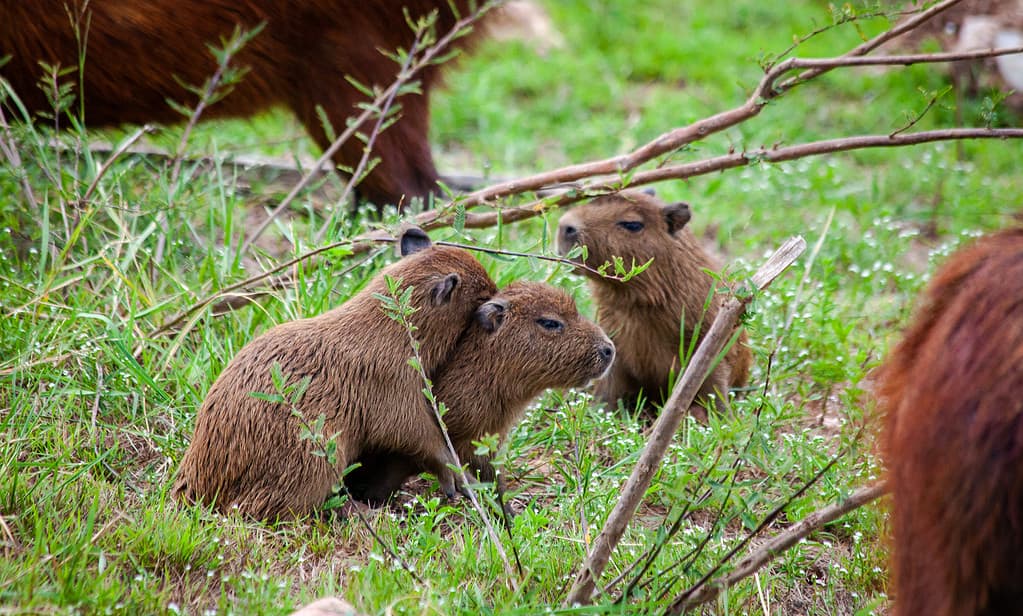
Baby capybaras are precocial. They are born active and ready to follow their mothers.
©Manon Le Charpentier/iStock via Getty Images
Capybara pups are precocial animals, meaning that they are born ready to get on their feet and move. They arrive covered with hair and well-developed, unlike some more familiar rodents, such as rats and mice. Humans are an altricial species. Our infants are born helpless and unable to move about on their own. Precocial species, like the capybara, can get up and follow their mothers soon after birth. Dogs and cats are good examples of altricial species, which have offspring that need time to develop before seeing, hearing, and moving about easily. Horses and giraffes, conversely, have precocial offspring that get up and walk or even run within a short time of being born.
5: Mother Capybaras Nurse Their Young Communally
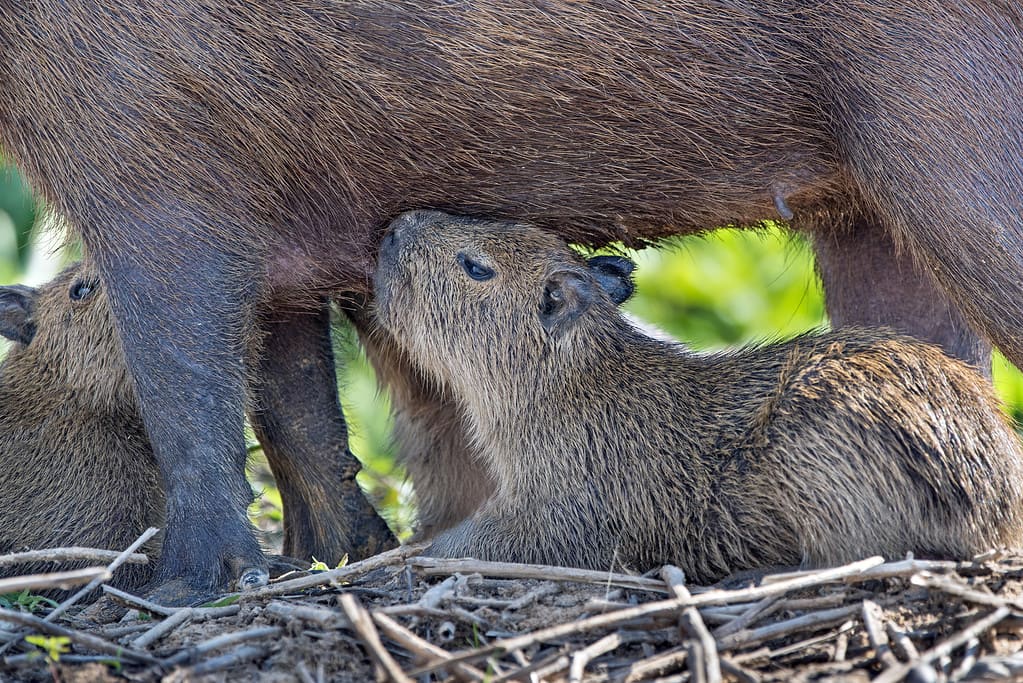
Capybaras nurse their babies communally. Baby capybaras will be nursed by any available mother in the family group.
©drferry/iStock via Getty Images
Capybaras live together in groups of 10 to 100 members, depending on the season. In the wet season, they usually live in smaller groups of between 10 and 40 members. But in the dry season, when water and preferred grasses get scarce, capybaras gather in larger groups that can reach up to 100 members. Within capybara groups, pups nurse from milk-producing females indiscriminately. A baby capybara will nudge a mother capybara to attempt to nurse, but if she does not stand up, it will move on to another mother and give her a nudge. The female capybaras may refuse to nurse hungry pups at a given time, but they don’t tend to reject other females’ pups in their preference.
6: Capybaras Grow Incredibly Fast

Capybara pups increase in size very quickly, learning from their family group as they grow.
©Marcel_Strelow/Shutterstock.com
When capybara pups are born, they weigh only 2 to 3 pounds. Their mothers wean them at about 16 weeks of age. By the time capybaras reach about 18 months, they average as much as 88 pounds. That increase equals roughly 35 times the initial weight of the pup. Capybaras can keep on growing, though. Some reach weights of about 174 pounds, and the largest known capybara exceeded 200 pounds.
7: Baby Capybaras Are Incredibly Vocal

Baby capybaras are very vocal. They continuously make noises like chirps, barks, and purrs.
©Michel VIARD/iStock via Getty Images
Have you ever been around a kid who just never stopped making noise? Talking, singing, humming, whistling, grunting, non-stop noise. Well, that pretty much describes every baby capybara. These incredibly vocal animals make various noises, from chirps, squeaks, and whistles to grunts, barks, and purrs. They use their voices constantly to communicate with one another and with the rest of the family group, and they all tend to talk simultaneously. Baby capybaras are a noisy crowd.
8: Baby Capybaras Are Especially Vulnerable to Predators
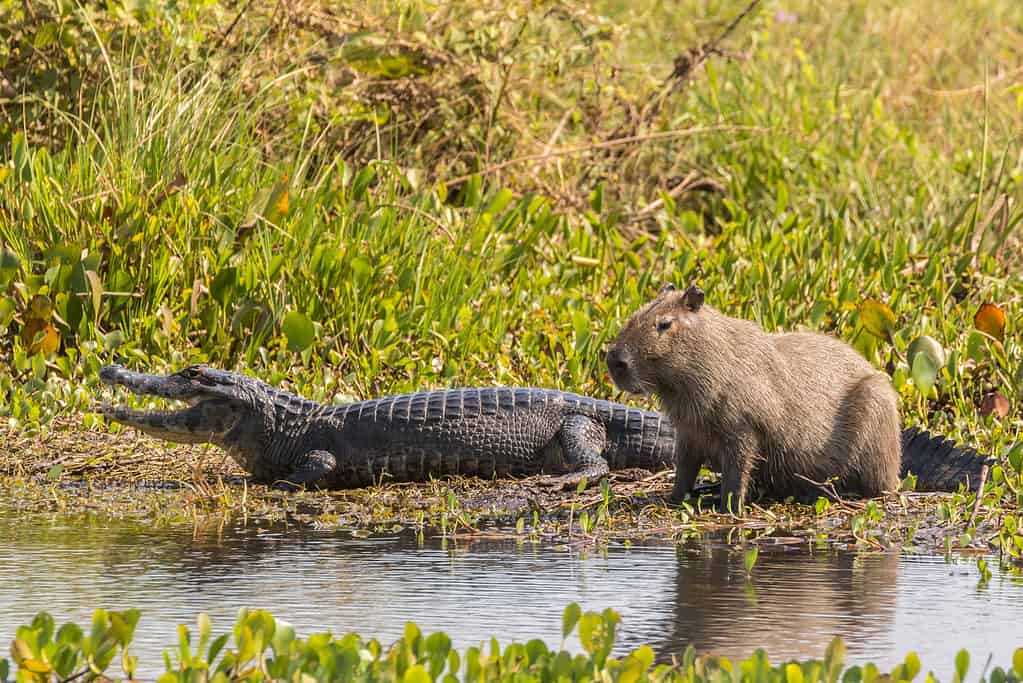
Because capybaras pose no threat, some large predators ignore them.
©Danita Delimont/Shutterstock.com
Capybaras typically have a lifespan of about 8 to 10 years in the wild. Predators are among their most significant threats. Capybara pups and young, subordinate males who tend to stay at the edge of a family group are most at risk. Capybaras face predators such as foxes, bush dogs and feral dogs, jaguars and ocelots, caimans and anacondas, and birds of prey such as eagles, black vultures, and caracaras. Of course, they have also often fallen prey to humans, though most human consumption of capybaras comes through managed farming now.
9: Young Capybaras Love the Water
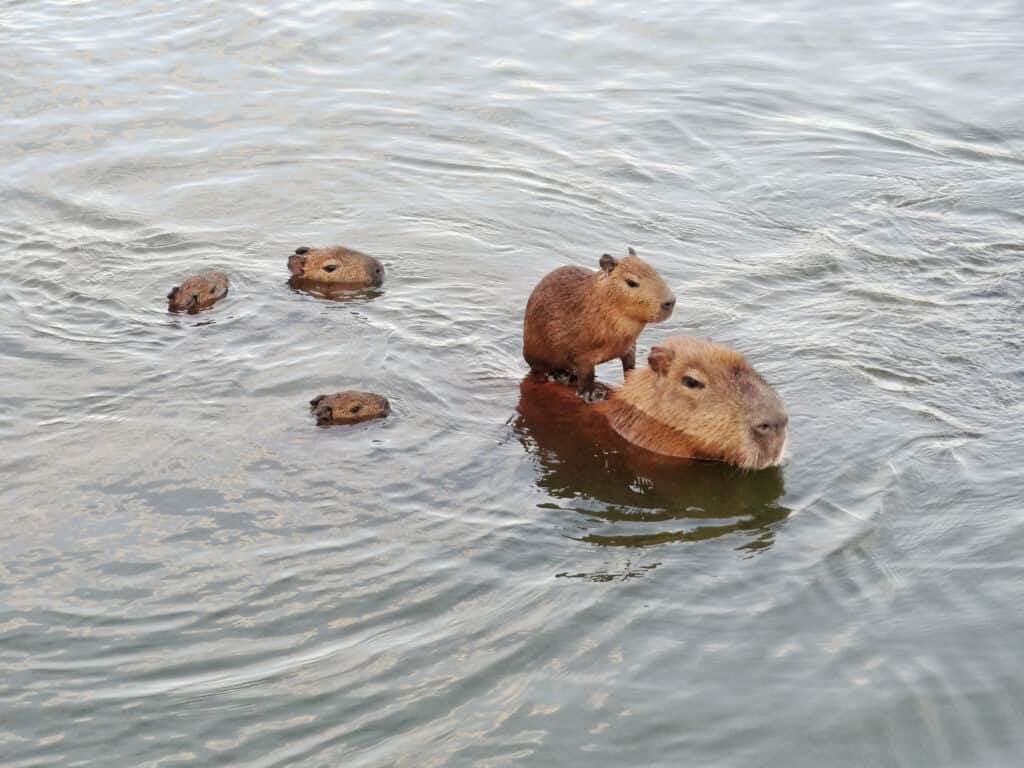
Baby capybaras cannot swim well when born, but they adapt quickly to the water.
©iStock.com/Yuina Takase
Capybaras belong to the genus Hydrochoerus. Two species exist, including the capybara, Hydrochoerus hydrochaeris, which lives throughout most of South America, east of the Andes, and the lesser capybara, Hydrochoerus isthmius, a smaller but distinct species that lives only in parts of Panama, Colombia, and Venezuela. Hydrochoerus derives from Greek words meaning water hog. Capybaras love the water and depend on it for protection from the sun and predators. The eyes, ears, and nostrils of capybaras are set high on their heads, like a hippopotamus, so they can spend long periods in the water. They can stay underwater for up to five minutes and nap easily with their heads just skimming the surface. A baby capybara cannot swim well at first, but it will adapt quickly to life in the water.
10: Capybaras Disperse at About One Year of Age

Young capybaras stay with their family group until they are about a year old.
©7caina lemes26/Shutterstock.com
Young capybaras leave their mothers by the time they reach about one year of age. They leave the groups they were raised in and head out to find new ones. Female capybaras will have reached sexual maturity by the time they go home. They mature between 7 to 12 months of age. Males do not reach sexual maturity until they reach about 15 to 24 months of age. They are destined to be subordinate males in their new groups until they are older.
Conclusion
Capybaras are fascinating animals, and baby capybaras are exceptionally cute. These gentle, active pups love to play and make lots of noises. They get along well with just about every other member of the animal kingdom. Hopefully, you enjoyed learning more about baby capybaras today. If you want to see capybaras, they are residents of many zoos and sanctuaries worldwide.
The photo featured at the top of this post is © Michel VIARD/iStock via Getty Images
Thank you for reading! Have some feedback for us? Contact the AZ Animals editorial team.



